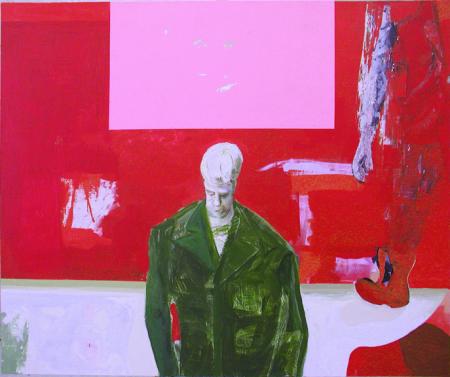
Untitled, (Little Soldier Red) 2005, Drake Deknatel
The paintings of Drake Deknatel are a bit like a faint sound in the distance. They are like the attempt at remembering something so familiar yet which somehow remains evasive. They are like descriptors of the mental space that surrounds the second after forgetting a dream. They stand between nightmare and love, between good painting and bad, between the tangible pictoral and the invisible metaphysical. It is an ephemeral experience which lingers. And this state of mind, this place in the brain is odd, slightly uncomfortable, difficult, and yet familiar.
Extended for another month at the Elizabeth Leach Gallery, Deknatel's show, "Berlin Portraits" is not to be missed. His work is a rich visual experience, part of the old world and the contemporary one at once, sharing traits with a wide variety of painters and artists to have also sought the description and depiction of this psychology with a similar romance. It is not necessarily an easy viewing experience, on either the eyes or the mind. Yet it is a more giving, more vulnerable, and somewhat more raw experience than Portlanders are accustomed to. The anomaly of this language in our quaint yet progressive city is welcome, refreshing, and somewhat grounding in the scope of art viewing, a connection to another place and time yet very much part of this one.
Deknatel's work is neither hip nor trendy, but more about the intrinsic power and timeless possibility of painted pictures. The images exist between abstraction and representation, and thus the more abstract paintings may be diagnosed as non committal or vague. Yet this is not the case; these works are Deknatel's attempt to reify the experience of existence, to depict the ephemeral soul moving within the weight of a fleshy form that must then move through its respective physical and psychological spaces. Deknatel's abstractions are this attempt. He seems to believe in the power of painting, to the point that one cannot deny the significance of even the smallest thing, and too tasteful editing is more detrimental than advantageous. This is painting that is not necessarily about good design, a trait uncommon to most art here in the northwest.
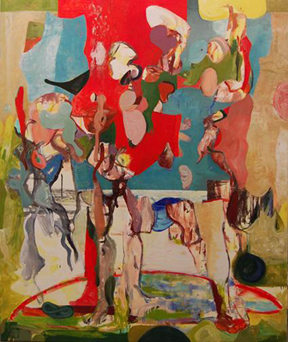
Seeflustern 2003, Drake Deknatel
Expression of Deknatel's experience is at the forefront of his priority, and he is uncompromising. There is a divide in the work, a disparity between the two halves of the show which the Elizabeth Leach Gallery has pronounced further by extending only one half for the second month of the show's run. The latter body of work is what can still be viewed in the gallery and is the more pronouncedly figurative. These more figurative paintings seem to strive more towards an image of what the experience might look like from the outside rather than the depiction of experience itself. They seem to admit to what the abstractions strive towards but cannot seem to reconcile. The figurative works are visually clearer, and compositionally more sophisticated. Through their anchoring in a more concrete form and world, their psychology is allowed to be more subtle yet somewhat more effective, or perhaps simply different. Francis Bacon and Neo Rauch are other painters who also recount this psychological space with the use of the figure within a very pointed created space.
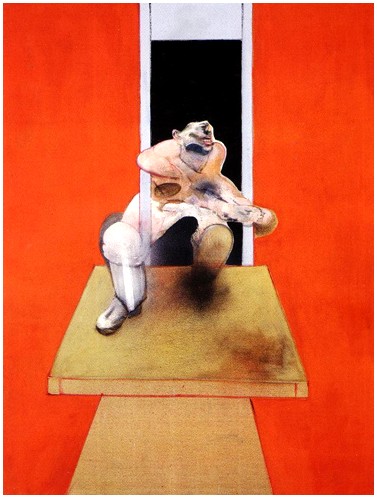
Figure in Movement, 1985, Francis Bacon
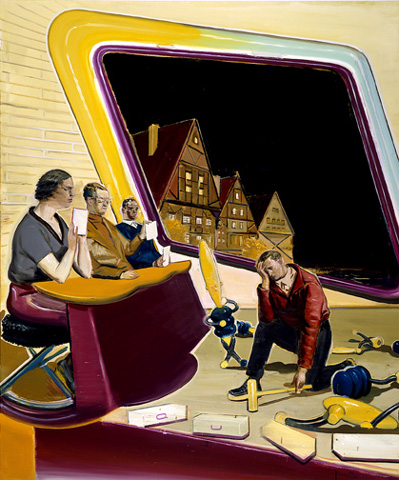
Quiz, 2002, Neo Rauch
The psychology of a semi real space combines with the faulty nature of memory and physical experience of human body to formulate a new thing with an old soul, a director of ghosts. Ironically, it is the limitations of real space that allows the fervor of Deknatel's imagination to run wild in a way that anchors him, the limitation ironically granting him more freedoms.
The fact that Deknatel's work was favoured in Germany is not surprising. His work seems to resonate on a very typical German keynote. German painters seem to often concern themselves with figuration while at the same time being very much aware of the expressive body of paint itself. There is an untidy viscosity of paint that is somewhat corporeal, somewhat yucky, that is atypical to American paint handling. Whether deemed 'good' painting or 'bad', it is an uncontrolled substance which makes us somewhat uncomfortable. This dichotomy between figuration and existential paint handling has the power to set up an interesting tension within each picture. German painters span the spectrum of this dichotomy with both calculation and emotion; Gerhard Richter uses paint as mechanism while Martin Kippenberger uses it somewhat as an affront.

Uncle Rudi, 1965, Gerhard Richter
It is an expressive history rife with a romance of the entirety of humanity. In ways it seems the evidence or visual story of the love affair with the totality of human psychology and experience. Whether or not many German intellectuals would agree with this sentiment is neither here nor there, as romance in itself is often offhandedly stereotyped. Yet, the ideas of pathos and surrender (whether intellectually or physically) and the quintessential German painter Max Beckmann's desire to paint "the fearful, commonplace, splendid and the average grotesque banality in life" was and is as romantic as the mystical intentions of Die Brucke.
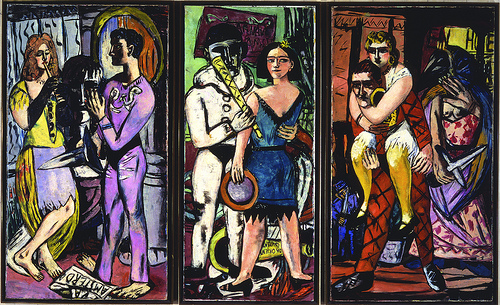
Karneval, 1943, Max Beckmann
There is an accompanying need to answer to the nature of one's identity as it is concerned with history, especially the history of war, which for the German identity is something which is absolutely undeniable and ever present. There is an intellectual vivacity and self conciousness which seem to create a common thread in this place, yet to which Deknatel also seemed to belong.
In essence, the paintings are an attempt at the reificiation of the experience of existence. To walk through space as a human is not to stand in a landscape of trees and gravity and buildings, but to move with one's psychology and history. Deknatel's work projects these colors onto the picture plane, and allows the shape of metaphysics to have impact. This work hints at the psychological possibility of a flat, painted picture plane in a contemporary forum while fostering and feeding the seductive romance of its own chosen medium .
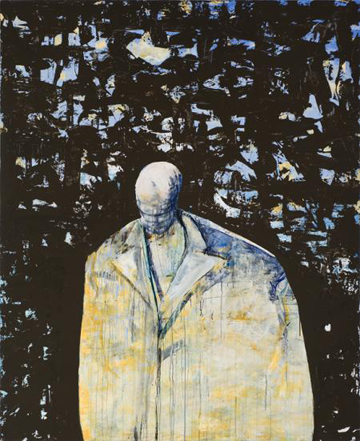
Out of the Woods, 2005, Drake Deknatel
If you want to do a lil ultra-German painting tour there are 2 nice Neo Rauch's at PAM right now and they almost always have Max Beckman's "The Mill" up. They also have a really large Polke up now too.
PAM's Untitled Kirchner (with the fir trees) is my favorite work in the collection and fits the German painting tour bill as well.
There is often this acidic nostalgia... even in pre WWII works.
Last but not least, the Rock
Paper Scissors show expands the discussion beyond German and painting nicely as a cap off.
A nice thing about Drake Deknatel's show is that if you view the show from left to right, there's a small and very poignant secret revealed at the end. At least it was a surprise for me, not knowing anything about the show before I saw it. No spoilers but the thing at the end adds layers of complication and a tragic note. I love it.



























![[TypeKey Profile Page]](http://www.portlandart.net/nav-commenters.gif)